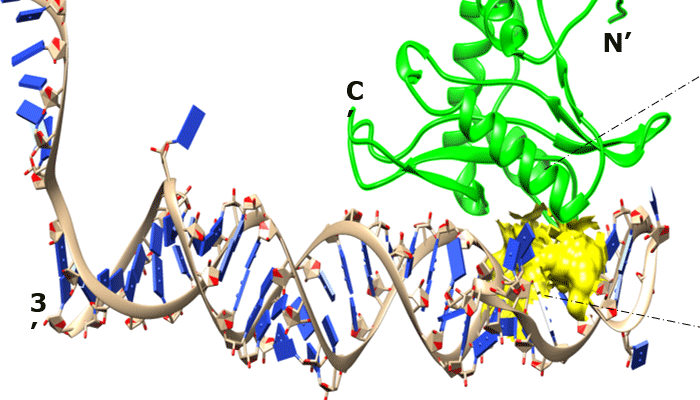
Aptamers: Binding molecules and binding disciplines
EDITORIAL
![]()
ISSN: 2514-3247
APTAMERS (2017), Vol 1, 1-2
Published online: 01 March 2017
Full Text (PDF ~175kb) | (PubMed Central Record HTML) | (PubMed) | (References)
Julian A Tanner*
School of Biomedical Sciences, University of Hong Kong, Hong Kong, PR China
*Correspondence to: Julian Tanner, Email: jatanner@hku.hk, Tel: +852 3917 9472, Fax: +852 2855 1254
Received: 27 February 2017
©Copyright The Author(s). First published by Library Publishing Media. This is an open access article, published under the terms of the Creative Commons Attribution Non-Commercial License (http://creativecommons.org/licenses/by-nc/4.0). This license permits non-commercial use, distribution and reproduction of this article, provided the original work is appropriately acknowledged, with correct citation details.
Welcome to the inaugural volume of Aptamers, the official journal of the International Society on Aptamers. It is now almost three decades since the classic breakthrough papers which established that short single-stranded nucleic acids can be selected and evolved from massive libraries to bind with high-affinity and specificity to molecular targets (Ellington and Szostak, 1990; Tuerk and Gold, 1990). Much has been achieved over the intervening years, but perhaps somewhat unusually there is now an exponential late blossoming of activity as aptamers are finding their impact across a wide range of fields and disciplines. Academic and industry researchers across diverse disciplines are seeing the many advantages of aptamers next to the standard molecular recognition workhorse of antigen-binding domains of antibodies. It may be fair to say that the advantages of chemical synthesis, lower costs and simpler integration with nucleic acid nanotechnologies are building an ever-greater gap in potential next to antibodies. The exploration of deep chemical evolutionary space beyond DNA and RNA is opening up possibilities really only limited by the imagination.
Aptamer research started with a molecular biology and biochemistry focus. This led to therapeutics achievements including Macugen/pegaptanib as the first VEGF antagonist for use in age-related macular degeneration (AMD) approved by the FDA in 2004 (Gragoudas et al, 2004). Two other aptamer-based drugs for ophthalmic use are in late-stage development (Drolet et al, 2016). Modified aptamers selected against thousands of targets have been arrayed as a proteomics tool for biomarker discovery (Hathout et al, 2015). In imaging, aptamers have been shown as a key tool for the first approaches in enable live-cell imaging of RNA (Paige et al, 2011). In drug delivery, aptamers encoded the logic gate for a therapeutics delivery system in a nanorobot (Douglas et al, 2012). Use of aptamers in diagnostics and sensing provides another opportunity to bind disciplines, with particularly exciting recent progress in electrochemical continuous aptamer-based sensors (Arroyo-Curras et al, 2017). The molecular biology and biochemistry origins of aptamer research led to hundreds of papers across the biomedical landscape. But there is significant opportunity for aptamer application in physical, electronics, nanotechnology, materials and environmental sciences that will no doubt also flourish in years to come. As is so often the case, innovation and invention emerge from interdisciplinarity which not only traverses fields but also brings together academic and industry researchers.
So this critical juncture is an opportune time to present the new open-access interdisciplinary peer-reviewed journal Aptamers. There has been a need to bridge and build a community of the many scientific disciplines involved in aptamer research with a journal having nucleic acid aptamers themselves as its focus. Aptamers will be a highly international journal with maximum global visibility and will be indexed by all the major scholarly databases. Aptamers will be accepting Full Research Articles, Short Communications, News, Reviews, Mini-Reviews, New Methods and Technologies, Research Letters and Meeting Reports. Promotion of excellence in aptamer research in terms of quality, impact and originality will be at the heart of the journal driven by thorough and rigorous peer review. We will consider both positive and negative data articles, acknowledging the often underappreciated value that rigorous high-quality negative data can have for the aptamer community. With no open-access fees until the end of 2017, we strongly encourage submissions to build a solid foundation for Aptamers as a focal point to facilitate collaboration and bring together the diverse international aptamers community.
COMPETING INTERESTS
None declared.
REFERENCES
Ellington AD and Szostak JW. 1990. In vitro selection of RNA molecules that bind specific ligands. Nature, 346, 818-822.
Tuerk C and Gold L. 1990. Systematic evolution of ligands by exponential enrichment: RNA ligands to bacteriophage T4 DNA polymerase. Science, 249, 505-510.
Gragoudas ES, Adamis AP, Cunningham ET Jr, et al. 2004. Pegaptanib for neovascular age-related macular degeneration. N Engl J Med, 351, 2805-2816.
Drolet DW, Green LS, Gold L and Janjic N. 2016. Fit for the Eye: Aptamers in Ocular Disorders. Nucleic Acid Ther, 26, 127-146.
Hathout Y, Brody E, Clemens PR, et al. 2015. Large-scale serum protein biomarker discovery in Duchenne muscular dystrophy. Proc Natl Acad Sci USA, 112, 7153-7158.
Paige JS, Wu KY and Jaffrey SR. 2011. RNA mimics of green fluorescent protein. Science, 333, 642-646.
Douglas SM, Bachelet I and Church GM. 2012. A logic-gated nanorobot for targeted transport of molecular payloads. Science, 335, 831-834.
Arroyo-Curras N, Somerson J, Vieira PA, Ploense KL, Kippin TE and Plaxco, KW. 2017. Real-time measurement of small molecules directly in awake, ambulatory animals. Proc Natl Acad Sci USA, 114, 645-650.



